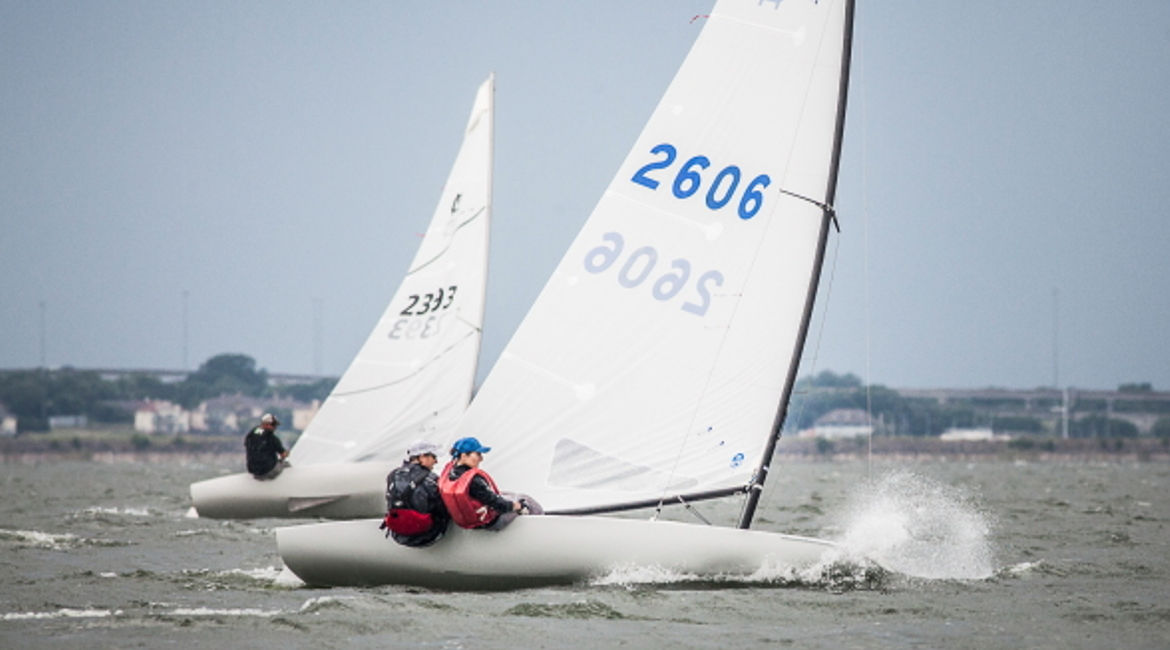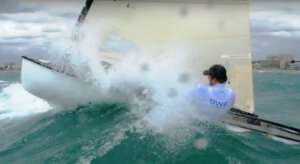The result was electrifying. The catamaran’s performance improved immeasurably, and from only one pound of weight reduction. Steve Colgate, in Steve Colgate on Sailing.
If we’re pitching too quickly, and frequency is the problem, we start spreading the crew, slowing the frequency and allowing the flow to stay attached to the sails. James Lyne/Dave Powlison in Sailing World.
When their jib man climbed back into the cockpit, they slowed down and we began to pass them for a second time. Robert Smither in Crew Weight and Weight Distribution (Lightning class website)
These quotes illustrate some nuances of weight distribution and boat speed.
- Steve Colgate is referring to the effect of removing one pound of weight from the mast of a catamaran sailing in waves.
- James Lyne claims that the conventional wisdom of keeping the crew close together may not always be fastest in waves.
- Robert Smither reminds us that fore and aft weight distribution makes a big difference in boat speed, independent of waves.
In this post, we’ll dig into these quotes to illustrate the importance of fore and aft weight distribution on boat speed in flat water and waves.
Fore and Aft Trim for Speed
In Does Hull Speed Matter for Small Boat Racing? we learned that the longer the waterline, the faster the boat. To maximize your waterline length, sail the boat on its lines, with the bow and stern “level” and at the proper angle of heel. If skipper and crew are too far aft, the bow will be out of the water; too far forward and the stern will be out. Both of these errors make the waterline shorter and the boat slower.
Many novice sailors sit too far back in the boat. You can see the stern dragging and the bow lifting. That’s what Robert Smither is getting at in the quote about the jib man. The crew weight was too far aft with the jib man in the cockpit, and the boat was slow. The entire crew should have moved forward.
Practice Tip:
Experiment with moving your weight forward. Watch your bow wave and try to get it as far forward as possible. Look at the wake from your stern and see if it is gurgling, indicating stern drag. Find a spot where the bow wave is forward and the stern wake is not gurgling. Don’t go too far forward – you don’t want the bow plowing or the stern out of the water. Have an outside observer take a look.
Reducing Moment of Inertia for Waves
Many boats are fast in flat water, but lose their edge in waves. Technique is probably the biggest factor, but you can also manage weight distribution to improve your boat speed in waves.
Moment of Inertia
Imagine this experiment, or try it for a more vivid impression: Hold a barbell at your side with the weights close to your hand. Use your wrist and forearm to rotate it back and forth in a horizontal plane and feel the resistance. Next, move the weights further apart and try the same thing. The bar is now much harder to start or stop rotating, because it has a greater moment of inertia.
Here’s a thought question: If you double the separation of the weights in this experiment, how much does the resistance to rotating back and forth increase? The answer is four times more, which is the square of the distance ratio. Separating the weights by 10 times the original distance would make the resistance 100 times more. Moment of inertia increases exponentially as weight is moved further from the rotation point.
Sailing Fast in Waves – Pitching
Watch expert dinghy sailors in waves. You’ll see plenty of body mechanics to help the boat get over the top of a wave, surf down, and then prevent the bow from digging into the next wave. For small boats, the key to sailing fast in waves is not to plow through them, but to ride up and over them. Thus, small boat sailors want boats to pitch back and forth easily. Reducing a boat’s resistance to pitching (moment of inertia) will make it faster in waves.
That’s why Steve Colgate saw a dramatic increase in performance simply by removing one pound of weight from the mast. It’s also why crew normally sit shoulder to shoulder near the fore and aft center of the boat.
Contrary Views
Making pitching easier may be counter-intuitive to some. You can find articles telling you to center the weight in the boat to reduce pitching. These articles have the right idea about weight placement, but for the wrong reason; centering the weight will increase pitching ability.
However, it’s worth paying attention to the articles quoted above by James Lyne and Robert Smither. There may be circumstances when you want to spread weight and reduce pitching, for example in lighter air when the pitching causes flow to become detached from the sails.
Reducing Weight Aloft and at the Ends
There are plenty of opportunities to reduce your boat’s moment of inertia, especially when you realize that distance is your friend. Removing 8 ounces of weight 10 feet from the center is 50 times as effective as removing a pound of weight 1 foot from the center.
Some sailors are fanatical about this topic. It is said that Frank Bethwaite considered removing screws from his bow plate after the holding epoxy cured. ILYA C-Scow sailors did moment of inertia measurements on boats they considered fast.
Here are some ideas. We’d love to hear yours.
- Have the skipper and crew sit as close to the center (fore and aft) as practical
- Get rid of any water in your boat quickly. Water always goes to the wrong place.
- Ensure drainage ports from one section of the boat to others are working
- Remove gear from under the deck or in the stern. Find a place nearer the center of the boat for stuff you need.
- Mount your tool pouch in the near the board box instead of under the front deck
- Find a lighter tiller
- Replace a bulky bow fitting with something lighter
- Replace metal fittings with spliced line
- Move control lines and blocks toward the center if practical
- Change wire rope to lighter synthetic rope if allowed
- Remove unneeded fittings from boom and mast
- Take the rub rail off the front of your boat
- Remove the boom crutch from the aft deck. Substitute a mid-ships version.
- If the space under the front deck is inaccessible, cut an access hole and inspect the area
- Consider lighter weight flotation panels or cubitainers if appropriate
Related Content:
Snipe Measurer’s Guide – contains a section on how to measure moment of inertia using springs
Sailors Helping Sailors
Will you share your knowledge with your related Comments below?




